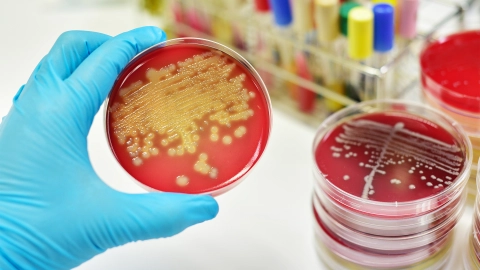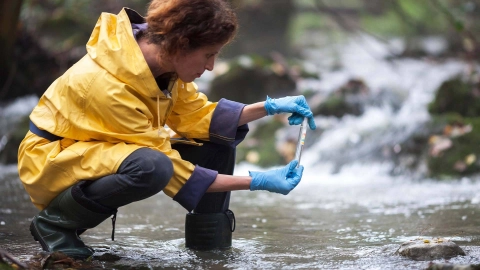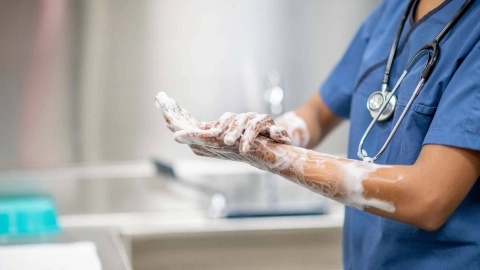Healthy living Antibiotic resistance – when medicine becomes powerless against bacteria
In modern medicine, antibiotics are indispensable. However, increasing numbers of bacteria are becoming resistant to antibiotics. This type of resistance is more likely to occur when antibiotics are used incorrectly.
At a glance
- Antibiotics are used to treat bacterial infections.
- Some bacteria are naturally resistant to certain antibiotics, while others develop antibiotic resistance over time.
- This type of resistance is more likely to occur when antibiotics are used too frequently or not as prescribed by a doctor.
- One well-known example of antibiotic-resistant bacteria is MRSA.
- General regulations on the use of antibiotic use and responsible use of these drugs by individuals can help ensure that antibiotics remain effective.
Note: The information in this article cannot and should not replace a medical consultation and must not be used for self-diagnosis or treatment.

What are antibiotics and what is antibiotic resistance?
Antibiotics are drugs used to fight bacteria. They can be used to treat bacterial infections. Antibiotics are not effective against viruses.
If antibiotics are used too frequently, unnecessarily or not as prescribed by a doctor, bacteria can become insensitive to them. This means that the antibiotics are no longer effective against the bacteria. This is known as antibiotic resistance.
Some bacteria have become resistant to commonly used antibiotics and some have even become “multi-resistant”. This means they are insensitive to several different classes of antibiotics. These “superbugs” can be dangerous. If there are no longer any drugs capable of fighting them, then they can cause infectious diseases that cannot be treated effectively. This could lead to a situation similar to that before antibiotics were discovered.
To combat the further development and spread of antibiotic-resistant bacteria, it is important, for example, to distinguish between viral and bacterial pathogens when treating infectious diseases. Doctors can use methods such as laboratory testing or rapid screening to identify viruses and bacteria. Prescribing an antibiotic only makes sense if the illness is caused by bacteria. However, an antibiotic is not always necessary when treating bacterial infections.
When are antibiotics used and how do they work?
Areas of application
Antibiotics are regularly used to treat antibiotic infections in both human and veterinary medicine. It should be borne in mind, however, that not every respiratory infection or urinary tract infection needs to be treated with an antibiotic. Examples of human diseases for which it is advisable and necessary to use antibiotics include:
- bacterial pneumonia
- bacterial sepsis (infection of the bloodstream)
- scarlet fever
- Lyme disease
- syphilis
- gonorrhea
- infectious endocarditis – a bacterial inflammation of the endocardium (the inner lining of the heart)
The fact boxes developed by the Harding Center for Risk Literacy explain the benefits and harms of using antibiotics to treat the common cold, acute bronchitis and a simple middle ear infection.
When used correctly, antibiotics are usually high effective and well tolerated by patients. This is because they attack certain structures that only exist in bacteria but not in human cells.
However, antibiotics have the drawback that they attack not only harmful, disease-causing bacteria, but also the useful bacteria that live in the human body. Useful bacteria are particularly plentiful in the intestines. These are known as intestinal bacteria or gut flora. If gut flora are destroyed by frequent use of antibiotics, it becomes easier for disease-causing bacteria to become established in the gut. These can cause chronic diarrhea, for example.
Important: To protect the helpful bacteria living in an on our bodies, antibiotics should only be used when absolutely necessary. Your family doctor will know when you really need an antibiotic.
Video What is the microbiome?
Watch this video to find out more about the microbiome and its functions in the human body.
This and other videos can also be found on YouTube
Watch nowThe privacy policy indicated there applies.
How do bacteria develop resistance?
Some types of bacteria are naturally insensitive, i.e., resistant to certain antibiotics. However, there are also many bacteria that, over time, have gradually become resistant to previously effective antibiotics.
New resistance develops due to changes in the bacteria’s genetic information. This process is known as gene mutation and it can occur randomly. If the mutation is beneficial to the bacteria, it is preserved and passed on to subsequent generations. Some bacteria can also transfer the resistance gene (the part of their genetic information that makes them antibiotic-resistant) to other bacteria. This process is called gene transfer.
Bacteria can become resistant to an antibiotic in a number of different ways. These include:
- preventing the antibiotic from entering the bacterial cell
- developing special pumps that transport the antibiotic back out of the bacterial cell
- changing the antibiotic’s point of attack so that it is no longer effective
- breaking down the antibiotic to render it ineffective
When treated with an antibiotic, resistant bacteria have a survival advantage over non-resistant bacteria. As a result, they multiply more effectively and win the upper hand. For this reason, hospitals are especially significant in relation to the development and spread of antibiotic-resistant bacteria that are dangerous to human health. A particularly large number of antibiotics are sometimes used in hospitals and in intensive animal farming, which puts pressure on the bacteria to develop resistance. If antibiotics enter the environment, this can also make antibiotic resistance more likely to develop. Therefore, measures to avoid antibiotic resistance need to be implemented across all areas – in human medicine, veterinary medicine and in environmental policies and practices. This is known as the “One Health” concept.
Important: The development of antibiotic resistance is enabled and accelerated if antibiotics are used excessively and incorrectly – for example, in the wrong dosage or not for the prescribed period of time.
How does antibiotic resistance develop?
Why is increasing antibiotic resistance problematic?
Certain people are particularly vulnerable to bacterial infections, for example, because their immune system is weakened and unable to fight bacteria effectively without support. These include, in particular:
- people with serious pre-existing diseases, such as cancer
- people with immunodeficiencies
- people whose immune system is suppressed by medication, for example, following an organ or stem cell transplant
- patients in intensive care units
- those of older age
These people depend on the availability of a sufficient number of effective antibiotics because even a harmless infection can be dangerous for them. People who are normally fit and healthy also require an antibiotic for certain bacterial infections, such as sepsis (infection of the bloodstream) or meningitis.
However, some bacteria have become resistant to commonly used antibiotics and some are even “multi-resistant” – in other words, they are insensitive to several different classes of antibiotics. One very well-known example is the “hospital bug” MRSA. MRSA stands for “methicillin/oxacillin-resistant Staphylococcus aureus”. However, other types, such as vancomycin-resistant enterococci (VRE) and multi-resistant Gram negative bacilli (MRGN), represent an ever-growing threat. VRE are intestinal bacteria that are resistant to certain antibiotics. MRGN is a large group comprising different types of bacteria – many of which also live in the intestines, though some are also to be found on the skin. Their common trait is that they are resistant to 3 or even 4 different classes of frequently used antibiotics.
Only a very small number of antibiotics, known as “reserve antibiotics”, are effective against these multi-resistant organisms (MROs) – also known as “superbugs”. As very few new antibiotics are expected to be developed in the foreseeable future, it is important to preserve the effectiveness of existing antibiotic medication. It is already the case that, in Europe alone, around 35,000 people die every year from serious infections with resistant bacteria because the available antibiotics can no longer treat them effectively. This affects infants and older people in particular.
What can be done to prevent the spread of antibiotic resistance?
Antibiotic resistance strategy
The problem of ever-increasing antibiotic resistance has been known about for a long time and strategies have already been developed to counteract the trend. Foremost among these is the Global Action Plan on Microbial Resistance, which was developed by the World Health Organization (WHO). In Germany, the German Antibiotic Resistance Strategy (“Deutsche Antibiotika-Resistenzstrategie”, DART) brings together the essential measures. Among other things, it envisages the monitoring of antibiotic consumption and resistance – this is known as antibiotic consumption surveillance (ACS) or antibiotic resistance surveillance (ARS). Other important measures concern the prevention of infectious diseases, appropriate use of antibiotics and collaboration in research and development.
Infection Protection Act
The German Infection Protection Act (Infektionsschutzgesetz) contains regulations that aims to help prevent antibiotic resistance. For example, there is a legal requirement to notify the relevant authorities of infections with certain resistant pathogens, such as MRSA. On this legal basis, a commission of the Robert Koch Institute (RKI) makes general recommendations for the diagnosis and treatment of infectious diseases.
Antibiotic stewardship
The concept of “antibiotic stewardship” refers to the appropriate and responsible use of antibiotics. For example, before prescribing an antibiotic, doctors should identify the microbe that is causing the disease before choosing a suitable antibiotic on this basis. After all, not every antibiotic is effective against every disease-causing germ. Decisions about treatment duration, dosage and form of antibiotic administration (e.g., in tablet form or as an infusion), should also be carefully considered.
What can we all do to halt the growth of antibiotic resistance?
In addition to the global measures described above, every individual can also play their part to slow the development of new forms of antibiotic resistance. This has a chance of success if we all strive to:
- be aware that antibiotics are only effective against bacteria and are ineffective in treating viral infections such as the common cold
- only take antibiotics that have been prescribed for us
- strictly follow medication instructions when taking antibiotics – this applies in particular to when to take them, for how long and how they interact with certain foods
- inform our doctor if any side-effects occur, rather than simply stopping the antibiotic treatment ourselves
- dispose of any left-over tablets with household waste rather than flushing them down the toilet
- purchase meat from farms that prioritize animal welfare, as these tend to use fewer antibiotics
- Adler N, Balzer F et al. Antibiotika und Antibiotikaresistenzen in der Umwelt: Hintergrund, Herausforderungen und Handlungsempfehlungen. Umweltbundesamt. 11/2018.
- Bundesamt für Verbraucherschutz und Lebensmittelsicherheit. Pressemitteilung: Abgabe an Antibiotika in der Tiermedizin sinkt weiter. Aufgerufen am 02.04.2025.
- Bundesregierung. DART 2030: Deutsche Antibiotika-Resistenzstrategie. 04/2023.
- Bundesinstitut für Öffentliche Gesundheit (BIÖG). Alle reden von Antibiotika-Resistenzen… Aber was ist das eigentlich? Aufgerufen am 02.04.2025.
- infektionsschutz.de. MRGN – Multiresistente gramnegative Bakterien. Aufgerufen am 02.04.2025.
- Cassini A, Högberg LD et al. Attributable deaths and disability-adjusted life-years caused by infections with antibiotic-resistant bacteria in the EU and the European Economic Area in 2015: a population-level modelling analysis. Lancet Infectious Diseases 2019. 19: 56-66.
- Füssle R. Prinzipien der Antibiotikatherapie. Anästhesiologie & Intensivmedizin 2011. 52: 896-910.
- Kassenärztliche Bundesvereinigung (KBV). Antibiotika – was Sie wissen sollten. Aufgerufen am 02.04.2025.
- Kassenärztliche Bundesvereinigung (KBV). Antibiotika-Resistenzen: Wenn Antibiotika nicht mehr wirken. Aufgerufen am 02.04.2025.
- Weltgesundheitsorganisation (WHO), Regionalbüro für Europa. Antibiotikaresistenz. Aufgerufen am 02.04.2025.
As at:






